Imperial Cycle – Dragon

With the Imperial cyle finally out, lets have a look at the Dragon specifically to see what cards in the new packs go into their decks.
For the Dragon, the Imperial Cycle opened up options but didn’t offer much for their primary deck. It opens up a few more options and develops themes, but overall Dragon seem to have received less when compared to the other clans.
The Monk theme was under-developed in the base set and received a good amount of support in this cycle. The Togashi Mendicant is a cheap 1 cost Monk character to help support the trait that will see play. Meanwhile, the Itinerant Philosopher is a slightly more expensive option at 2 with similar stats that probably will not. In the conflict side, Centipede Tattoo and High Kick are two great Monk only options. Mantra of Water is the second of the Mantras but is unlikely to see play until the other Mantras do. Currently, it looks like small monks such as the Togashi Mendicant and Togashi Initiate will see play as support characters to allow the use of High Kick in conflicts.
The fate manipulation theme gets a number of interesting options including the two unique attachments Jade Masterpiece and The Stone of Sorrows which allow their owner, in some manner, take control of fate on rings. The event Written in the Stars is a little more complex, letting you add 1 point of fate to all rings without fate or move 1 fate from all rings to the pool. As of yet, it’s unclear how effective this will be.
The primary deck focused on building powerful units with attachments, adds Agasha Sumiko to its lineup from the Dragon cards in the set. Due to her powerful ability, The Imperial Palace is a great addition to the deck. Kitsuki Yaruma is an interesting option due to his ability and the new province Public Forum. Yaruma doesn’t completely fit with the deck style as it is often preferable to produce him without fate to allow Courtesy trigger and later copies enter play. Dragon found more benefit in the neutral cards with Feast or Famine an instant addition to the province line up. On the conflict side Finger of Jade is the primary card of interest helping protect the Dragon units from effects that would discard or disrupt them. As Dragon currently have a Seeker role and the Niten Master is an important character for the deck, the Crab card Pathfinder’s Blade is appearing in many Dragon decks.
Characters
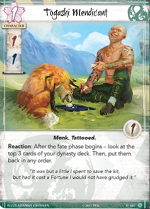
This dynasty Monk character is 1 fate for 1 military, 1 political, and 1 glory. As a reaction, after the fate phase. beings you can look at the top three cards of your dynasty deck and then put them back in any order. This is a minor benefit but will give you a little bit of information that you can use. If you have a holding in play or a character that you are considering keeping, you will be able to tell whether you should discard those cards or are better off keeping them. It will allow you to place dynasty cards in the province you want. It can, for example, be used to place a holding such as The Imperial Palace onto either an unbroken province to get use from its +2 province strength or onto a broken province to make sure it cannot be discarded by your opponent during the turn. As a 1 cost character, this Monk is likely to come into play with 0 fate and leave at the end of the turn. This will give a character which can be bowed for High Kick or can be a target for Mantra of Fire or Mantra of Water. He goes along with the Togashi Initiate as a cheap support character.
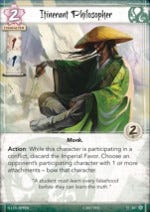
This Dragon Monk character has a similar stat line to the Seeker Initiate, at 2 cost for 1 military, 1 political, and 2 glory. The typical stat line for a 2 cost character seems to be 2 in one skill and 1 in the other, so this is a little understated. This is the reason the Seeker Initiate isn’t commonly played even though the ability is quite good. The Itinerant Philosopher’s ability is similar, it is a powerful effect but requires a specific condition. In this case, you need to discard the favor to bow an opposing character with an attachment. This effect is similar to that of the Niten Adept, who is considered very strong. The target condition is actually easier to fulfill as you can always drop one of your own attachments on the opposing character. Discarding the favor is a trickier prospect though, and while it can happen it limits the use to once per turn regardless of whether you have multiple Philosophers or the Way of the Dragon attached. As another Monk, he might find a place in early Monkdecks but doesn’t appear to be a great investment.

This is the Dragon’s entry in the Magistrate theme where characters skill will not apply during conflict resolution under specific conditions. Enigmatic Magistrate is a 3 cost 2 military, 2 political, and 1 glory Bushi character. While attacking only characters with odd fate costs apply their skill during resolution, so only 1 cost, 3 cost, and 5 cost characters get their skill. I’m assuming here that this game considers 0 to be even. The stat line isn’t great, and he doesn’t have a trait the Dragon are interested in. So this is all about the ability. As with the other Magistrates, anything that changes the way the game is played is a powerful tool. In this case, if it is not to your advantage then you only assign the Magistrate on defense, negating his ability. He also allows for a powerful charge target, unexpectedly changing how a conflict will play it. Unlike many of the other Magistrates, the Enigmatic Magistrate will depend on what characters other clans are playing. If the most played characters are even cost, then the Magistrate will be very reliable, but if they are odd, then he won’t be.
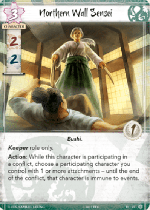
As this is a Keeper only card, and as Dragon currently are Seeker this is not currently a legal card for tournament play. This is another 3 cost character with 2 military, 2 political, and 1 glory stats I do consider poor. As a conflict action you can target a character, you control in the conflict with at least 1 attachment and make them immune to events. As it happens in a conflict, this is best used as a first action on the defense. On the attack, it leaves a window for the defending player to play an event before you can take the action. If you use this ability on another character, the Northern Wall Sensei remains vulnerable to an event. You can use the ability on the Northern Wall Sensei who, if alone, will then leave your opponent with no targets for events. With poor stats and an ability your opponent can often work around, this doesn’t seem like a great character. On those days when you can get the Sensei to protect your Deathstar unit, it could be game-winning.

This Courtier is a 4 cost character with 2 military, 4 politics, and 2 glory. This is Dragon’s second Courtier along with the excellent Kitsuki Investigator. The 4 political skill is important, this is a number that will allow Yaruma to solo provinces and effectively use Outwit. He has Courtesy, so when he leaves play, you get a fate back. As the character is unique, only one copy can be in play and additional copies are going to give him more fate. This makes the Courtesy keyword a little less useful, especially on a high-cost character, as it is less likely to trigger.
He has a reaction when entering play to turn an unbroken province card face down allowing an ‘on reveal’ province a second attempt. The ability is, unfortunately, too situational to be worth relying on. Your opponent needs to have attacked an ‘on reveal’ province but not broken that province. Then, Yaruma needs to appear. As Yaruma is unique, if you already have Yaruma in play then you won’t be able to play the second copy.
Yaruma cannot have poison attachments, currently this only stops the Scorpion card Fiery Madness. Mechanically this isn’t a big deal as the Scorpion are only going to find another target. This is actually very relevant for the story, according to the Wikia for the old story his son was kidnapped by the Scorpion and raised as Bayushi Tokai. The Scorpion maneuvered Tokai into place as the Emperor’s food taster. As the Kitsuki are immune to poison, when the Scorpion poisoned the Emperor’s food, Tokai who inherited his father’s immunity showed no ill effects.
Unfortunately, Yaruma is a little too disjointed, his ability and Courtesy are unlikely to be useful, so really it is whether a 2/4 for 4 fate is worthwhile. This might help Dragon stretch to a Courtier deck, but he is likely to be removed as soon as another option comes along. Update – Yaruma has been quite popular. All the above is still true, but his ability can be great on occasion. If you play him without fate and he can flip a fire province, courtesy gives you 1 fate back and the province revealing again gives you another, so he ends up a 2 cost character with 2 military and 4 political which is really good.
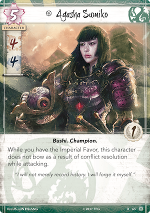
Currently, Agasha Sumiko is the Ruby Champion and, in the Emerald Champion’s absence, she is also charged with protecting the Emperor and his family. As a 5-cost Bushi, Sumiko must be compared to other characters in that range, including clan champions. Her military and political skill of 4 are underwhelming for a clan champion, but about typical for other 5 cost characters. With only 1 glory she isn’t great for honoring, but also doesn’t suffer too much from dishonor. Her ability means she does not bow due to conflict resolution when attacking if you have the Imperial Favor. This isn’t the blow-out ability of Kakita Yoshi or Ikoma Ujiaki, but it does mean she can attack twice and if you are the first player then defend, potentially allowing her to contribute to 3 conflicts without involving any other cards. She also works well with the currently unreleased The Stone of Sorrows, which only is active while the attached character is ready. Despite the high cost, this is a character that will immediately fit into existing Dragon decks. Typically she will be mulliganed away first turn, but any turn where the Dragon deck starts with the Favor she will be very welcome.
Holdings
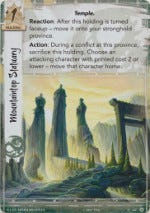
This Dragon holding raises some interesting rulings questions. My interpretation here is based on the card doing what it says and no rules in the rules reference saying it can’t. At +1 province strength, it offers a minor defense buff to a province. The action allows it to sacrifice itself (which will remove its +1 PS bonus) to move an attacking character with 2 or less fate cost home. Alas, it doesn’t send them home bowed, but it does get them out of the conflict. If it appears in a province, it is likely your opponent won’t bother attacking it, or, if they do, will account for the ability. If it ended there, this would scarcely be a playable card. However, as a reaction, after Mountaintop Sanctuary comes into play, you can move it onto your stronghold province. This means you can end up with 3 copies of the Sanctuary sitting on your stronghold when your opponent finally attacks it. This makes for an incredibly well-defended stronghold province. The question then is whether it is worth focusing on a card that defends your final province rather than helping you take their provinces faster. If the environment turns out to be very well balanced, where victory is often decided by who the first player is on the final turn, and is able to attack first into their opponent’s stronghold, a card like this could win games.
Attachments

The Seal of the Dragon is a 0 cost attachment that gives +1 political, the Dragon clan symbol, and Monk trait. Currently, the Monk trait is used for a limited number of abilities. This includes High Kick, Mantra of Fire, Mantra of Water, Centipede Tattoo, and the ability on Ascetic Visionary. Like the seals of the other clans, there are a few cases where you could be tempted to play it but it is probably not worth the investment of the card.
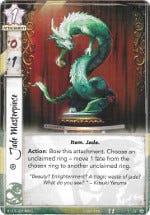
This is a 1 cost unique attachment that gives +0 military and +1 politics. As an action, you can bow the attachments to move 1 fate from an unclaimed ring to another unclaimed ring. It is quite typical for there to be 2 fate spread across two rings from turn 2 onward. The Masterpiece allows for a two options: First, to move fate onto the ring you already want and then declare that ring. Second, to move fate away from the ring your opponent wants.
This can be especially relevant when you are using abilities such as Togashi Initiate, Kitsuki Investigator, or Enlightened Warrior which require moving fate onto rings. This also helps scoop up fate that will accumulate while the yet to be released The Stone of Sorrows remains in play or with the event Written in the Stars. It is likely this card will pay for itself, although, as it does cost a conflict card you would hope it will do more than pay for itself. This is a potential piece is a fate dominance game that the Dragon are clearly setting up for. Just like every other Dragon card it is 2 influence.
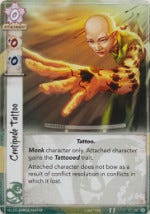
This 0-cost attachment can only be attached to a Monk character. When the attached character loses a conflict, they don’t bow during resolution. This is another tool in the Dragon ‘force multiplier’ toolbox. In theory, you could lose 3 conflicts and still assign to a fourth. Obviously, losing so many conflicts wouldn’t be desirable. There are two primary ways to effectively use Centipede Tattoo. The first way is to threaten a weak attack by just assigning a small character with the tattoo. Your opponent then either has to let you win the conflict and net a cheap ring, or else win the conflict themselves and bow their defenders, while the Monk remains ready for the next conflict. The second use is to act as a ‘speed bump’ in defense, providing enough skill to save the province, but not win the conflict. The Dragon have a very interesting Monk deck developing and this will be a strong component in it.
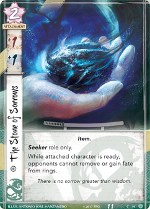
The Stone of Sorrows was likely the reason that Dragon Hatamoto at worlds decided to pick a Seeker role. This 2 cost attachment gives +1 military and +1 political and while the character it is attached to remains unbowed, your opponent cannot collect fate from rings. As fate on rings is the primary way to gain additional fate this card could have a big impact. In addition to denying your opponent fate, it allows you to take that fate the next time you declare that ring, eventually paying for itself. It reduces the risk of actions that require spending fate to rings like the Togashi Initiate, Ascetic Visionary, and Kitsuki Investigator. It keeps more fate on rings for cards like the Enlightened Warrior and Seeker of Enlightenment. It’s not all upside though, if your opponent can destroy the card or bow the character they will be able to turn off the effect. If you’ve been spending fate to rings in the expectation that your opponent couldn’t take it, this could make a mess of things. You also need to make sure your character is unbowed, so this might mean relegating a character to support duty unable to assign until after your opponent has declared their last conflict. Alternatively, you try to keep it on characters that have straighten effects like the Niten Master or don’t bow like Agasha Sumiko.
Events
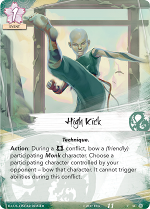
This 1 cost event can only be used during a military conflict and requires bowing a friendly monk character in the conflict. It bows an opposing character and prevents them from triggering actions during the conflict. Bow actions are some of the most effective in the game, not only do they prevent the bowed character from contributing their skill but, unlike send home actions, it also prevents them from assigning to another conflict. The drawback for bow actions is the target can still use their ability. High Kick is the best of both worlds. Currently, Dragon have 3 dynasty and 2 conflict monks with at least 1 more already spoiled. They can also play the Seeker Initiate who is another monk. Bowing your own monk can minimise the benefits, but this remains a high impact card. Although he didn’t see play in the core environment, with this additional bow action Ascetic Visionary is much improved. On the attack you can bow a monk and then straighten it paying 1 fate to use the Visionary’s ability. As this is military only, opponent’s are safe in political conflicts. As the Tattooed Wanderer is a conflict character monk, during a military conflict there is always the chance a Dragon player will have a High Kick ready.
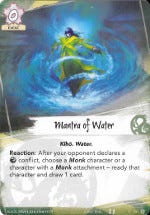
This is the second Mantra after the Mantra of Fire. When your opponent declares a Water conflict: you can play this card, straighten a monk character (or character with monk attachment), and draw a card. Looking at this card, it’s surprising the Mantra of Fire doesn’t honor a character instead of adding fate. It will be interesting to see what the eventual Mantra of Void will do. Mantra of Fire did not see play in the core environment due to how conditional it is and the low number of playable monks. With the increase in card pool, the monk pool is increasing for the Dragon which will help this. The second condition is your opponent selecting the ring in question, until they do this card sits in your hand unused. A typical game will take 3 to 4 turns with your opponent declaring around 6 conflicts in total. Initially, ring selection will be dependent on the rings effect on the board state, but as the game progresses the fate sitting on the rings becomes more important. So it is likely that your opponent will at some point select the water ring. Will you have the monk you need in play? Will that monk be bowed? Will you have drawn the Mantra of Water? If you do this will be a big effect and will replace itself with another conflict card. If you don’t, it is a dead card. Right now, I think Mantra of Fire is better as the monk can be bowed or unbowed. Once that sees play, we can start thinking about Mantra of Water.
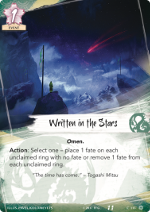
This 1 cost event continues the theme of Dragon manipulating fate. The effect gives two options, place 1 fate or remove 1 fate on every unclaimed ring. On turn 1 this could allow you to play 5 fate onto rings straight away. Typically you will want to play this effect right before you attack, so you will regain the fate for the event when you declare a conflict. This would then boost the Seeker of Enlightenment potentially adding 4 skill. It could also be used to make sure the Enlightened Warrior triggers as your opponent will have to pick a ring with fate on it. This effect also combos with the attachment Jade Masterpiece allowing you to move an extra fate generated onto the ring you are going to declare an attack with. The other effect is to remove 1 fate from all the rings. This could be used to deny your opponent fate but at a cost of 1, it seems somewhat lackluster as you’ll at best deny your opponent 1 fate and might also remove fate you would have otherwise claimed.
This Dragon deck retains the basic concept developed during the core environment. Agasha Sumiko and the The Imperial Palace provide an extra super unit while the Pathfinder’s Blade powers up the Niten Master. Cheap Monks have been added to provide the trait required to use High Kick to help take out opponent’s big units.
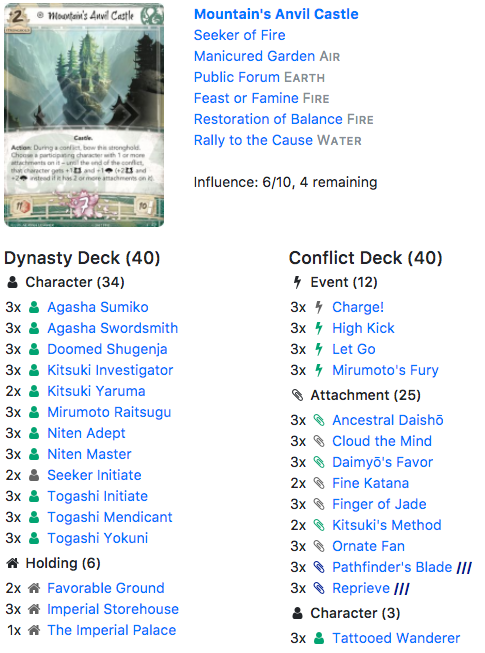

One Reply to “Imperial Cycle – Dragon”
I would be remiss to not mention the work the Dragon clan are currently doing on refining this deck. Kingsley proposed an early version a few packs in and Mirumoto Kenzo posted an updated decklist here.
I’m sure there will be a few more iterations before the exact list is finalised, but basic core of it seems solid.